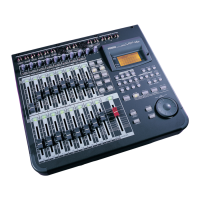80
Trk 1 & 2 &
3 & 4 & 5 &
6 & 7 & 8
Trk 9 & 10
& 11 & 12
& 13 & 14
& 15 & 16
Trk 17 & 18
& 19 & 20
& 21 & 22
& 23 & 24
Program 1 (P01)
Program 2 (P02)
Program 99 (P99)
Trk 1&2
Trk 3&4 Trk 21&22
Trk 23&24
Program 1 (P01)
Program 2 (P02)
Program 99 (P99)
Trk 1 & 2 & 3 & 4 & 5 & 6 &7
& 8 & 9 & 10 & 11 & 12 & 13
& 14 & 15 & 16 & 17 & 18 &
19 & 20 & 21 & 23 & 24
Program 1 (P01)
Program 2 (P02)
Program 99 (P99)
Chapter 6 Save/Load of song data
******About song data******
There are three methods of saving/loading song data depending on the digital signals used to handle
the data, which are S/PDIF digital, adat digital and SCSI. The format and time required for the save/load
operations are different between each method.
•Using the S/PDIF digital signal (you can save/load data for each program individually.):
Following to five seconds of the pilot signal (shown in gray in the diagram below), the song data is output to a DAT.
The audio data is divided into data blocks of track pairs (shown in black in the diagram below) and transferred. To
save data for Real tracks 1 through 16, 8 two-track data are transferred. To save all tracks including the Additional
tracks in addition to the Real tracks, 12 two-track data are transferred. Therefore, it will take about 8 times as much
as the recorded time of a program (from ABS 0 to REC END) to save the Real tracks 1 through 16 of the program,
while it will take about 12 times to save all the data including the Additional tracks. When loading song data from
the DAT to the VF-16 via the S/PDIF digital signal, data is transferred with two-track data blocks, as with the same
way as saving data from the VF-16 to the DAT. (See also <Notes> on the next page.)
•Using the adat digital signal (you can save/load data for each program individually.):
After the pilot signal (shown in gray in the diagram below) which takes approximately 5 seconds, the song data is
output to an adat machine. The audio data is divided into data blocks of 8 tracks (shown in black in the diagram
below) and transferred. To save Real tracks 1 through 16, two 8-track data are transferred. To save all tracks
including the Additional tracks in addition to the Real tracks, three 8-track data are transferred. Therefore, it will
take about twice as much as the recorded time of a program (from ABS 0 to REC END) to save the Real tracks 1
through 16 of the program, while it will take about 3 times to save all the data including the Additional tracks. When
loading song data from an adat machine to the VF-16 via the adat digital signal, data is also transferred with eight-
track data blocks, as with the same way as saving data from the VF-16 to an adat machine. (See also <Notes> on the
next page.)
•Using a SCSI disk (you can save/load data for each program individually.):
When using a SCSI disk, all audio data including both the Real and Additional tracks (shown in black in the diagram
below) is transferred simultaneously. Therefore, you can save or load a program much faster than using the S/PDIF
or adat signal. Note that no pilot tone or beep sound is recorded when saving data to a SCSI disk. If song data to be
saved requires more space than the available disk space, you can save the data to more than one disk (up to 99
disks). You can also save/load data to/from a DOS formatted disk by the WAV file format. In the save/load operation
using the WAV file, you can specify a track to be saved or loaded, as well as all tracks.
You can save or load the desired song data (including audio and various setup data) of the current program
to a DAT or adat recorder, as well as a SCSI backup device.
This function allows you to save finished or unfinished song data to a digital recorder such as a DAT and adat
or a SCSI backup device, and load the data later.
<Note>
You can save (load) scene memories and scene event
memories only to (from) a FDMS-3 formatted SCSI disk.
Scene memories and scene event memories can be saved
or loaded when using a SCSI device (except WAV).

